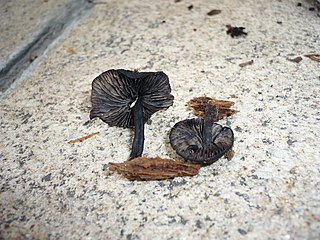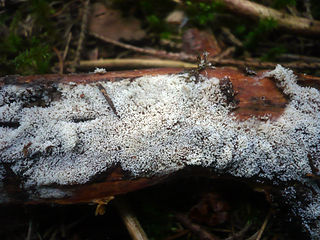| Amyloflagellula | |
|---|---|
| Scientific classification | |
| Kingdom: | |
| Phylum: | |
| Class: | |
| Order: | |
| Family: | |
| Genus: | Amyloflagellula |
| Type species | |
| Amyloflagellula pulchra | |
Amyloflagellula is a genus of fungi in the family Marasmiaceae.

The Marasmiaceae are a family of fungi in the order Agaricales. Basidiocarps are most frequently agarics, but occasionally cyphelloid. According to a 2008 estimate, the family contained 54 genera and 1590 species, but molecular research, based on cladistic analysis of DNA sequences, has led to a more restricted family concept, so that the Marasmiaceae included just 13 genera, and some 1205 species. It was reduced further down in 2020, to 10 genera and about 700 species.

The Phanerochaetaceae are a family of mostly crust fungi in the order Polyporales.

Podoscypha is a genus of fungi in the family Meruliaceae. The genus has a widespread distribution, especially in tropical regions, and contains about 35 species.

Cymatoderma is a widely distributed genus of poroid fungi in the family Meruliaceae.
Cyphellocalathus is a genus of fungi in the family Tricholomataceae. This is a monotypic genus, containing the single species Cyphellocalathus cecropiae, found in Bolivia.
Palaeocephala is a genus of fungi. This is a monotypic genus, containing the single species Palaeocephala cymatelloides, described by Rolf Singer in 1962. According to the Dictionary of the Fungi, the genus is classified in either the Marasmiaceae or Physalacriaceae families; the taxonomical database MycoBank includes it in the Marasmiaceae.
Aphyllotus is a fungal genus in the family Marasmiaceae. This is a monotypic genus, containing the single species Aphyllotus campanelliformis, found in Colombia. Both the species and the genus were described by mycologist Rolf Singer in 1973.
Cephaloscypha is a fungal genus in the family Marasmiaceae. This is a monotypic genus, containing the single species Cephaloscypha morlichensis. The genus and species were described by mycologist Reinhard Agerer in 1975.
Deigloria is a genus of agaric fungus in the family Marasmiaceae. Described by mycologist Reinhard Agerer in 1980, the genus contains 10 species that are widespread in neotropical areas. The generic name derives from the Latin words Deus (God) and gloria (glory).
Epicnaphus is a genus of mushroom-forming fungi in the family Marasmiaceae. The genus, circumscribed by mycologist Rolf Singer in 1960, contains two species found in South America. Fruitbodies of Epicnaphus species are similar in appearance to those in Marasmius section Sicci, but have a smooth hymenium and broom cells of the Rotalis-type. Singer initially included only the type species, E. phalaropus, which was originally collected from fallen branches in a Bolivian rainforest. The Argentinian species E. longispora was added to the genus by Jörg Raithelhuber in 1973.

Hydropus is a genus of fungi in the family Marasmiaceae. The widespread genus contains about 100 species, especially in tropical areas, but is not well represented in temperate regions. About 15 taxa are found in Europe; H. floccipus has the widest distribution in western Europe. Hydropus was circumscribed by Rolf Singer in 1948. Species in the genus have fruit bodies with caps that are mycenoid, collybioid, or omphaloid in form. Most species occur in tropical and subtropical regions, where they grow as saprobes on rotting wood, forest litter, and mosses. Generally, most Hydropus species are rare, and several are known only from the type collection, including H. conicus, H. moserianus, H. nitens, and H. paradoxus.

Lactocollybia is a genus of agaric fungi in the family Marasmiaceae. The widespread genus contains 17 species, many of which are found in tropical areas.
Manuripia is a fungal genus in the family Marasmiaceae. It is a monotypic genus, containing the single species Manuripia bifida, found in South America.
Nothopanus is a genus of fungus in the family Marasmiaceae. The genus was circumscribed by American mycologist Rolf Singer in 1944.

Rectipilus is a genus of cyphelloid fungi in the family Marasmiaceae. The widespread genus contains nine species. It was circumscribed by Reinhard Agerer in 1973.

The cyphelloid fungi are a group of fungi in the Basidiomycota that have disc-, tube-, or cup-shaped basidiocarps, resembling species of discomycetes in the Ascomycota. They were originally referred to the genus Cyphella and subsequently to the family Cyphellaceae, but are now known to be much more diverse and are spread through several different genera and families. Since they are often studied as a group, it is convenient to call them by the informal (non-taxonomic) name of "cyphelloid fungi". Better known cyphelloid genera include Calyptella, with stalked, cup- or bell-like fruit bodies; Lachnella, with conspicuous, hairy-margined, disc-like fruit bodies; Flagelloscypha with smaller, but equally hairy, cup-like fruit bodies; Henningsomyces with tube-like fruit bodies; and Merismodes with clustered, hairy, cup-like fruit bodies.

Xenasmatella is a genus of corticioid fungi in the order Polyporales. Circumscribed by German mycologist Franz Oberwinkler in 1966, the widespread genus contains 14 species.
Heteroscypha is a genus of fungi in the order Auriculariales. Species form cup-shaped, cyphelloid basidiocarps with basidia that are wholly or partly septate. They are presumed to be saprotrophic, growing on dead wood. Originally described in the Tremellales, the genus was placed in its own family, the Heteroscyphaceae, by Jülich and included within the Auriculariales by Wells. Further research is required to determine its true disposition.